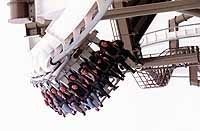|
Top Picks || Arts & Entertainment || Business & Economy || Education & Society ||
THEME PARK THRILLS: New Rides, Attractions Pack People into Amusement Parks September 22, 1998  Heart-stopping thrills and speed are drawing crowds to new rides in Japan. (Jiji Press) With the arrival of summer, amusement parks throughout Japan become crowded with families and young people. The most popular attractions are the so-called scream machines, which thrill visitors with daunting height and speed and attract the longest lines. These rides, designed to boost the adrenaline levels of riders, are also the magnets that draw customers to the parks' gates. Each park bills its main attraction as the "world's best" or "world's fastest" in an attempt to lure customers away from its competitors. Dropping from a 35-Story Building Roller coasters equipped with linear motors are the latest trend. Coasters blast off from a standstill to speeds of up to 100 kph (62 mph) in a matter of seconds, giving riders a 4.5-G experience. Other rides are springing up one after another. Fujikyu Highland, located at the base of Mt. Fuji, boasts what it calls the "king of coasters," Fujiyama, whose height, speed, and steep drops are among the most thrilling anywhere. Amusement parks' showcase attractions also include roller coasters ridden in a standing position and bungee-jump-type rides--something for everyone. Escalating Costs and Radical Designs Most scream machines feature an innovative array of twists and turns built to stimulate the riders by confusing their sense of equilibrium. Such thrill rides, however, tend to lose their luster after a while for experienced riders. As riders become more demanding, more and more capital is required to build ever more exciting rides in order to continue attracting customers. Some parks began to find it difficult to turn a profit under the weight of their heavy investments. Life After Roller Coasters The Tokyo area is anticipating an onrush of new theme parks beginning in 2001. At least four parks financed by major corporations are currently in the works. What kind of attractions will these twenty-first-century parks devise to please Japan's pleasure-seeking souls?
 Edited by Japan Echo Inc. based on domestic Japanese news sources.
Articles presented here are offered for reference purposes and
do not necessarily represent the policy or views of the Japanese
Government. Edited by Japan Echo Inc. based on domestic Japanese news sources.
Articles presented here are offered for reference purposes and
do not necessarily represent the policy or views of the Japanese
Government.
|
